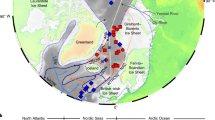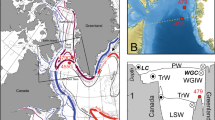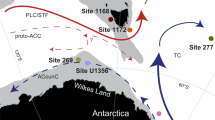Abstract
The two main constituent water masses of the deep North Atlantic Ocean—North Atlantic Deep Water at the bottom and Labrador Sea Water at an intermediate level—are currently formed in the Nordic seas and the Labrador Sea, respectively1. The rate of formation of these two water masses tightly governs the strength of the global ocean circulation and the associated heat transport across the North Atlantic Ocean2. Numerical simulations have suggested a possible shut-down of Labrador Sea Water formation as a consequence of global warming3. Here we use micropalaeontological data and stable isotope measurements in both planktonic and benthic foraminifera from deep Labrador Sea cores to investigate the density structure of the water column during the last interglacial period, which was thought to be about 2 °C warmer than present4. Our results indicate that today's stratification between Labrador Sea Water and North Atlantic Deep Water never developed during the last interglacial period. Instead, a buoyant surface layer was present above a single water mass originating from the Nordic seas. Thus the present situation, with an active site of intermediate-water formation in the Labrador Sea, which settled some 7,000 years ago, has no analogue throughout the last climate cycle.
This is a preview of subscription content, access via your institution
Access options
Subscribe to this journal
Receive 51 print issues and online access
$199.00 per year
only $3.90 per issue
Buy this article
- Purchase on Springer Link
- Instant access to full article PDF
Prices may be subject to local taxes which are calculated during checkout




Similar content being viewed by others
References
Marshall, J. & Schott, F. Open-ocean convection; observations, theory, and models. Rev. Geophys. 37, 1–64 (1999).
Weaver, A. J., Bitz, C. M., Fanning, A. M. & Holland, M. Thermohaline circulation: High latitude phenomena and the difference between the Pacific and Atlantic. Annu. Rev. Earth Planet. Sci. 27, 231–285 (1999).
Wood, R. A., Keen, A. B., Mitchell, J. F. B. & Gregory, J. M. Changing spatial structure of the thermohaline circulation in response to atmospheric CO2 forcing in a climate model. Nature 399, 572–575 (1999).
White, J. W. C. Don’t touch that dial. Nature 364, 186 (1993)
Aagaard, K., Swift, J. H. & Carmack, E. C. Thermohaline circulation in the Arctic Mediterranean seas. J. Geophys. Res. 90, 4833–4846 (1985).
Dickson, R. R. & Brown, J. The production of North Atlantic deep water: Sources, sinks and pathways. J. Geophys. Res. 99, 12319–12341 (1994).
McCartney, M. S. Recirculating components to the deep boundary current of the northern North Atlantic. Prog. Oceanogr. 29, 283–383 (1992).
McCartney, M. S. & Talley, L. D. Warm-to-cold water conversion in the northern North Atlantic Ocean. J. Phys. Oceanogr. 14, 922–935 (1984).
Schmitz, W. J. Jr & McCartney, M. S. On the North Atlantic circulation. Rev. Geophys. 31, 29–49 (1993).
Talley, L. D. & McCartney, M. S. Distribution and circulation of Labrador Sea Water. J. Phys. Oceanogr. 12, 1189–1205 (1982).
Dickson, R. R., Lazier, J., Meincke, J., Rhines, P. & Swift, J. Long-term coordinated changes in the convective activity of the North Atlantic. Prog. Oceanogr. 38, 205–239 (1996).
Shackleton, N. J. Oxygen isotopes, ice volume and sea level. Quat. Sci. Rev. 6, 183–190 (1987).
Yu, E. F., Francois, R. & Bacon, M. P. Similar rates of modern and last-glacial ocean thermohaline circulation inferred from radiochemical data. Nature 379, 689–694 (1996).
Keigwin, L. D., Curry, W. B., Lehman, S. J. & Johnsen, S. The role of the deep ocean in North Atlantic climate change between 70 and 130 kyr ago. Nature 371, 323–326 (1994).
Adkins, J. F., Boyle, E. A., Keigwin, L. & Cortijo, E. Variability of the North Atlantic thermohaline circulation during the last interglacial period. Nature 390, 154–156 (1997).
de Vernal, A., Rochon, A., Turon, J.-L. & Matthiessen, J. Organic-walled dinoflagellate cysts: palynological tracers of sea-surface conditions in middle to high latitude marine environments. Geobios 30, 905–920 (1997).
National Oceanographic Data Center World Ocean Atlas CR-ROM (National Oceanic and Atmospheric Administration, Boulder, 1994).
Hillaire-Marcel, C., de Vernal, A., Bilodeau, G. & Stoner, J. Changes of potential density gradients in the northwestern North Atlantic during the last climatic cycle based on a multiproxy approach. Am. Geophys. Union. Monogr. (in the press).
Kohfeld, K. E., Fairbanks, R. G., Smith, S. L. & Walsh, I. D. Neogloboquadrina pachyderma (sinistral coiling) as paleoceanographic tracers in polar oceans: Evidence from Northeast Water Polynya plankton tows, sediment traps, and surface sediment. Paleoceanography 11, 679–699 (1996).
Andreasen, D. J & Ravelo, A. Tropical Pacific Ocean thermocline depth reconstruction for the last glacial maximum. Paleoceanography 2, 395–413 (1997).
Faul, K., Ravelo, A. C. & Delanay, M. L. Reconstructions of upwelling, productivity, and photic zone depth in the eastern equatorial Pacific ocean using planktonic foraminiferal stable isotopes and abundances. J. Foram. Res. 30, 110–125 (2000).
Bond, G. et al. Pervasive millennial-scale cycle in the North Atlantic Holocene and glacial climate. Science 278, 1257–1266 (1997).
de Vernal, A. et al. Sea-ice cover and sea surface conditions in the Arctic and circum-Arctic during the Holocene: Preliminary results and methodological issues. Can. Geophys. Union Mtg (abstr.) (2000).
Dickson, R. R., Meincke, J., Malmberg, S. A. & Lee, A. J. The “great salinity anomaly” in the Northern North Atlantic 1968–1982. Prog. Oceanogr. 20, 103–151 (1988).
de Vernal, A., Miller, G. & Hillaire-Marcel, C. Paleoenvironments of the last interglacial sensu lato in northwest North Atlantic regions: eastern Canada and adjacent seas. Quat Int. 10-12, 95–106 (1991).
Shackleton, N. J. in Méthodes Quantitatives d’étude des Variations du Climat au Cours du Pléistocène (ed. Labeyrie, J.) 203–209 (Editions du CNRS, Paris, 1974).
Wu, G.-P. & Hillaire-Marcel, C. Oxygen isotope compositions of sinistral Neogloboquadrina pachyderma tests in surface sediments: North Atlantic Ocean. Geochim. Cosmochim. Acta 58, 1303–1312 (1994).
Dansgaard, W. et al. Evidence for general instability of past climate from a 250-kyr ice-core record. Nature 364, 218–220 (1993).
Hillaire-Marcel, C. (ed.). The Labrador Sea during the late Quaternary. Can. J. Earth Sci. (Special issue) 31 (1994).
Stoner, J. S., Channell, J. E. T. & Hillaire-Marcel, C. A 200 kyr geomagnetic stratigraphy for the Labrador Sea: Indirect correlation of the sediment record to SPECMAP. Earth Planet. Sci. Lett. 159, 165–181 (1998).
Acknowledgements
This study is a contribution to the Climate System, History and Dynamics project, supported by the National Science and Engineering Research Council of Canada, and to the international Images program. Complementary support by the Fonds pour la Formation de chercheurs et l’Aide à la Recherche of Quebec Province is acknowledged.
Author information
Authors and Affiliations
Corresponding author
Rights and permissions
About this article
Cite this article
Hillaire-Marcel, C., de Vernal, A., Bilodeau, G. et al. Absence of deep-water formation in the Labrador Sea during the last interglacial period. Nature 410, 1073–1077 (2001). https://doi.org/10.1038/35074059
Received:
Accepted:
Issue Date:
DOI: https://doi.org/10.1038/35074059
This article is cited by
-
Atmospheric and oceanic circulation altered by global mean sea-level rise
Nature Geoscience (2023)
-
Dampened predictable decadal North Atlantic climate fluctuations due to ice melting
Nature Geoscience (2023)
-
Deep-Water Circulation over the Last Two Glacial Cycles Reconstructed from Authigenic Neodymium Isotopes in the Equatorial Indian Ocean (Core HI1808-GPC04)
Ocean Science Journal (2022)
-
Evidence for influx of Atlantic water masses to the Labrador Sea during the Last Glacial Maximum
Scientific Reports (2021)
-
Southwest Greenland shelf glaciation during MIS 4 more extensive than during the Last Glacial Maximum
Scientific Reports (2019)
Comments
By submitting a comment you agree to abide by our Terms and Community Guidelines. If you find something abusive or that does not comply with our terms or guidelines please flag it as inappropriate.



